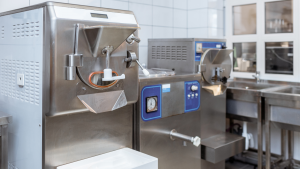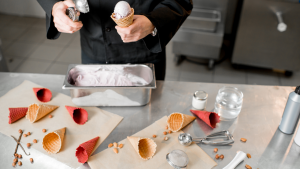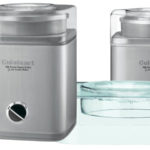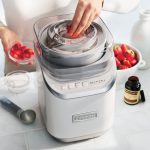Cuisinart ICE-30BC Ice Cream Maker Review - Based on all reviews and technical specifications Cuisinart…
How Do Ice Cream Makers Work?
Let’s face it, making ice cream at home is always exciting. Now if you’ve found yourself asking how do ice cream makers work, then you’ve stumbled upon the perfect article to break it down.
Ice cream making is a satisfying process that you can do by hand or with the help of electric machines. Knowing how the different ice cream makers work will give you a better idea of which one will be the most fun and efficient to use.
Ice cream making at home also allows you to control a lot of factors: its flavour, texture, plus the amount of added sugar and preservatives. So, whichever ice cream maker you decide to use, you’ll be able to experiment with a bunch of different homemade ice cream recipes.
Below we cover how electric, soft serve, rock salt, and an old-fashioned ice cream maker works so you’ll have an idea which one is best for you!

How Do Electric Ice Cream Makers Work?
Making ice cream with an electric ice cream maker is extremely convenient. While some models use a bowl that needs to be popped into the freezer before use, others have their own self-refrigerating system.
Electric ice cream machines produce ice cream by churning all the ingredients well until a thick, creamy texture is achieved. An electric ice cream maker machine has three main parts:
- Internal Canister: This is where you pour in all your ingredients.
- External Drum: The internal canister is placed inside this drum.
- The Churn: This part is driven by an electric motor that mixes all the ingredients until they solidify.
The primary benefits of a countertop electric ice cream maker are that it’s straightforward to use, achieves results in practically no time, and requires little maintenance.
How do Soft Serve Ice Cream Machines Work?
Soft serve ice cream machines work nearly identical to electrical ones. The only difference they have is the level of temperature they reach.
Many ice cream confectioners have defined soft serve as melted ice cream. While the ingredients are mixed in the same way as regular ice cream, soft serve is served at a lower (yet, still cold) temperature to give it that soft, melting texture.
If you decided to pour soft serve in a bowl and freeze it, you’d end up with regular ice cream. But since the ingredients are practically the same, you can experiment with different flavours and even add chunkier ingredients to make your soft serve mixture.
If you have a near-commercial level soft serve machine, you can purchase dry soft serve ingredients. While you can’t customize the flavour, these work great for quick ice cream making!
Read full review: Cuisinart ICE-45 Soft Serve Ice Cream Maker

How Do Rock Salt Ice Cream Makers Work?
The rock salt ice cream making method is the easiest no-machine ice cream-making process there is. You only require ice, rock salt and sealable plastic bags.
Rock salt differs from table salt and is usually cheaper. Its granules are cut to retain a large size which makes lowering the freezing temperature of water quicker. When making rock salt ice cream, you can use a double-stacked ice cream maker or zip-lock bags, which work great for smaller portions.
The process relies on the chemistry between ice and salt to freeze the ice cream ingredients. The rock salt reduces the freezing point of water, leading to the ice melting. As the ice melts, residual heat from the ingredients puts a slow freezing process in motion.
To make rock salt ice cream without a machine, you’ll need one large zip-lock bag and another smaller one. You can start by putting all your ingredients in the smaller bag then securing it tightly. Afterward, place the smaller bag inside the larger one. Fill the large ziplock bag with ice and rock salt then seal it. Once you make sure that both bags are sealed tight, stir and mix the ice and salt to freeze the ingredients in the middle. Within a few minutes, the liquids will start freezing!
Making ice cream using this method is more fun than using an electric ice cream maker, and if you have kids, you can give them the bags to play with and mix while watching the ice cream form.
A 1-to-5 ratio of rock salt to ice is recommended. Too much salt will cause rapid freezing, leading to a brittle texture. Likewise, too little salt will lead to watery ice cream.
How Does an Old–Fashioned Ice Cream Maker Work?
No matter the make or model, almost every old-fashioned ice cream maker works the same. They can be defined as a mixture between rock salt and electrical machines, but the cranking is done by hand.
Old-fashioned ice cream makers consist of a wooden bucket containing a freezing mixture of ice and salt, a metal inner container, and a paddle attached to a crank handle.
In this double-stacked machine, the ice cream ingredients are added to the inner container while the ice and rock salt are in the outer wooden bucket. You’ll have to work the handle to move the paddles that churn the liquid ingredients until they’re frozen. When your ice melts, you’ll have to replace it until you reach your desired ice cream texture.
Making ice cream the old-fashioned way puts you in more control of its consistency. Although it requires manual labour and can be pretty tiring, it surely leaves you feeling satisfied and proud!
To Recap: How do ice cream makers work?
While neither is typically better than the other, electric ice cream makers offer more convenience than other types. However, if you’re willing to let comfort take the backseat for a nostalgic experience, you can opt for an old-fashioned ice cream maker machine.
Whichever you choose, the end result will always be a delectable ice cream recipe paired with the satisfaction of having made your cold dessert yourself!
After reading this article, I hope that you’re no longer wondering how ice cream makers work. Only that, you also now have an idea of which ice cream maker works best for you.

Join Me In The Fun of Making Ice Cream at Home!
Hi, my name is Simone and I LOVE making and eating ice cream. I have searched long and hard to find the best ice cream maker reviews and tips on the best ice cream makers.
Find out a little more about myself and the IceCream Maker Guru gang here.
Thanks for visiting and may your ice cream always be delicious!
Simone xx
Trending Now
Categories
Recent Posts
Most Popular Posts
Share with Friends
Related Posts
-
Cuisinart ICE-30BC Ice Cream Maker Review
-
Cuisinart ICE-30BC Ice Cream Maker Review
Cuisinart ICE-30BC Ice Cream Maker Review - Based on all reviews and technical specifications Cuisinart…
-
Cuisinart Ice Cream Maker Comparison – Find the Best Cuisinart Ice Cream Maker for You
Money can never go wrong when you want to invest in a Cuisinart ice cream…






